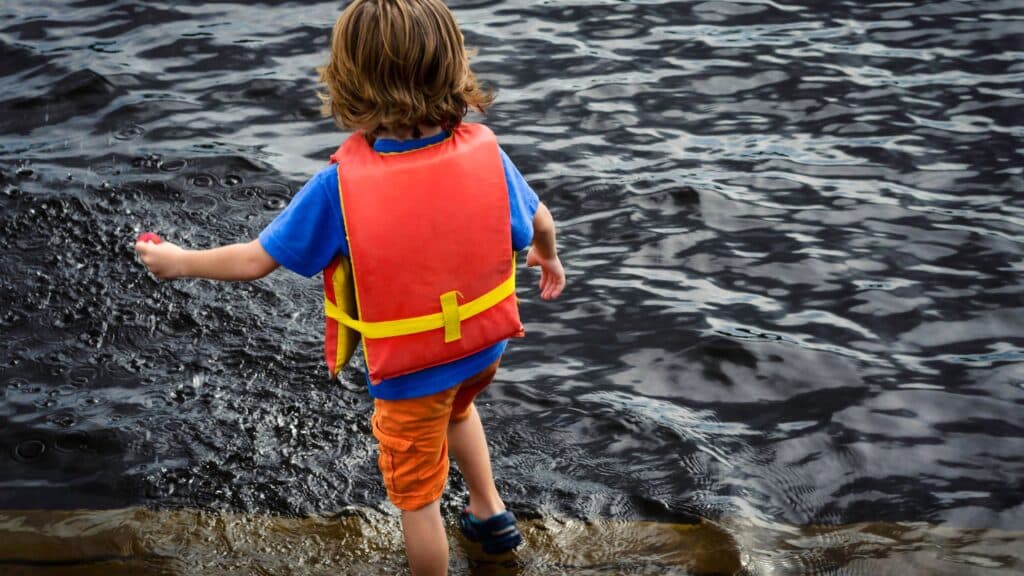Picture this: It’s a perfect summer day and your crew is pool-bound. You’ve managed to sunscreen them all up, pack a cooler full of snacks and towels, and you even remembered their fave goggles. But before a toe hits the water, it’s essential that you and your caregiver (and, any adult who will supervise your kids this summer) brush up on key water safety tips. From toddler pool safety to water readiness basics, these water safety tips for kids are just as essential as buckling their seatbelt. Because water safety isn’t just a checklist: it’s a skill set every caregiver and parent should feel confident in.
Why Water Safety for Kids Matters
Familiarizing yourself with water safety essentials isn’t just a one-and-done task that you can check off your list once; it’s imperative that parents and caregivers like nannies or mother’s helpers brush up on key water safety tips yearly—and now as we head into warm weather months, is an optimal time to do just that!
According to the CDC, more children ages 1-4 die from drowning than any other cause of death. In fact, just recently the three-year-old son of influencer Emilie Kiser reportedly drowned in a backyard pool. While the child’s death set off a barrage of news coverage, the fact remains that it’s essential that parents and caregivers prioritize water safety, especially for toddlers and those with increased risk of drowning. Adults play a critical role in water supervision, and guess what? It’s important to review the basics even if you don’t have a trip planned to the pool, lake or beach in the future because drownings can happen anywhere, even right at home.
Hyper Vigilant Supervision: The First and Most Important Line of Defense
Helicopter parents may get a bad rep, but when it comes to kids and water, there’s no shame in hovering because drowning can come fast and silently. The American Academy of Pediatrics (AAP) reports that in 2017, drowning claimed the lives of almost 1,000 US children. While we don’t know the exact circumstances of each incident, we do know that being hyper vigilant with your kids around water is the best thing you can do to prevent an accidental drowning death.
Of course, you and your caregivers may think, I know what it means to supervise kids, but watching them around water (especially when there is more than one child) is entirely different from supervising them at a playground. Below are some tips to ensure you’re supervising effectively and strategically. Review these tips with any adult who will be around your child with water nearby—it’s imperative you both are on the same page when it comes to water safety and supervision tactics.
- Rule #1: Get rid of distractions. This means no cell phones, no multitasking, no chatting with friends or even other kids. We know this may sound drastic, but getting distracted is so easy as a parent, especially if you’re in a social situation. When there’s water, 100% of your attention should be on the kids you’re tasked with watching.
- Rule number #2. Handing off supervision. Of course, you’ll need to hand off supervision to another grown-up at some point—whether that’s to run to the bathroom, grab a snack, or a sip of water. When this happens, make it a point to directly engage with the other grown-up who you are handing off supervision duties to. Allison of Busy Toddler, uses a tactic that airline pilots rely on when handing over the reins in the cockpit. She says, “When airline pilots need to make a change of controls in the cockpit, the pilot currently flying says: ‘Your airplane.’ This signals a change of controls is coming. The other pilot must respond back with ‘My airplane,’ acknowledging that they are now flying the aircraft.” When switching duties, Allison tells her husband “your kids,” and her husband responds, “my kids.” This verbal agreement is the official handoff. We love this tactic, and you can watch more about her approach here.
- Rule #3: Touch supervision. For any toddler or child who is not a strong swimmer, an adult should always be within an arm’s length of them. This will often mean that you need to get into the pool with your child if they are further than an arm’s length away from you. And yes, this rule even applies when they have a flotation device on.
Related: What Nannies Do & Their Responsibilities
Home Pool Safety: Keeping Things Safe at Home
People, especially our littles, tend to feel most at ease in familiar environments (as they should!), but don’t let that comfort lead to lowered guardrails—especially around water. If your family has a home pool or frequently visits friends with backyard pools, it’s important to take proactive safety measures, even if you are super comfortable in that environment. We’ve outlined a few essential pool safety tips to minimize risk below. Just remember: no amount of equipment or planning is a substitute for active, focused supervision.
Set pool rules with your child and nanny
Just like sleep schedules and screentime limits, water and pool rules should be consistent, communicated properly and often, and non-negotiable. This also goes for any family or child visiting your home, if they’ll be using your backyard pool. Here are some areas you’ll want to cover and reinforce often:
- Never swim without an adult present
- Always ask before entering the water
- Do not tamper with, climb over or try to unlock the pool gate
- Walk near the pool
- Stay away from drains and filters
Install pool safety fences
The AAP outlines that families should install a 4-ft, 4-sided isolation fence that separates the pool from the house and the rest of the yard with a self-closing, self-latching gate. The gate to the pool safety fence should be closed and locked at all times—no exceptions.
Add layers of protection with barriers, alarms, and covers
Use technology to your advantage! Below are some ideas on what to buy and what to install to enhance security around your pool. Of course, the below products shouldn’t be relied on for actual supervision.
- Door and gate alarms alert you when someone enters the pool area unexpectedly.
- Pool surface alarms can detect waves or movement in the water.
- Motorized safety covers help keep the pool securely closed when not in use, but they should never replace fencing.
- Window alarms can be especially helpful if your home has direct access to the pool.
Review and practice emergency protocols
Ensure your nanny or caregiver knows how to respond in an emergency. Everyone supervising kids should be CPR-certified, know the address to give to emergency responders, and have a phone nearby during swim time.
Related: How to Find a Nanny: A Comprehensive Guide
Water Safety Beyond the Pool
Backyard pools are just one place kids are exposed to water, but other environments (think: rivers, lakes, beaches, and even bathtubs and buckets of water) can be just as risky. This is why water safety should be a year-round, all-situations conversation that every caregiver and adult should be a part of. Here are some common water hazards to be aware of:
Bathtubs and Other Home Water Hazards
Even the slightest bit of water can pose a big risk for kids, especially babies and toddlers. In-home drowning accidents involving young children happen in bathtubs, buckets, water tables, baby pools, and even toilets. Here are some tips to keep your littlest one safe at home:
- Never leave a child unattended in the bath or water table, even for a moment
- Gather everything you need (towel, soap, toys) before turning on the water
- Keep toilet lids closed and consider child-proof latches for added security
- Empty all buckets, water tables, and tubs immediately after use and store them upside down
Lakes, Rivers, and Beaches: Open Water Safety
We love a beach day or a lazy inner tube trip down the river, but natural bodies of water can come with unpredictable elements like currents, waves, uneven surfaces, and debris. To enhance water safety when enjoying water play, here are some tips to remember:
- Always use U.S. Coast Guard-approved life jackets for kids. While parents often rely on pool noodles or puddle jumpers, these don’t count or truly cut it. Just because your child has a puddle jumper on, doesn’t give you permission to relax your supervision. It’s a false safety net.
- Remember the touch supervision we covered earlier? The same goes for lakes, rivers and beaches. Emphasize with your kids that they should never swim alone and to always stay within arm’s reach of an adult in or near water.
- Look for designated swim areas with lifeguards when possible, and avoid swimming near boat traffic or fast-moving water.
- Make a habit of checking water depth and temperature before jumping in.
- When at the beach, familiarize yourself with what a rip tide looks like (this is a handy visual) and if your children are strong swimmers and plan to go in the water, always use a buddy system because even the strongest swimmers aren’t immune to rip currents and strong undertows. This video is also helpful and shows what to do if you get stuck in a rip current (hint: don’t fight it, swim parallel to shore).
- Never turn your back to the waves as sneaker waves are real and can knock littles off their feet in an instant.
Related: Nanny & Caregiver Burnout: What It Is & How to Avoid It
Boating Safety
Boating brings added excitement and added responsibility. Before stepping on that boat, here are some things to keep in mind:
- Coast Guard-approved life jackets are non-negotiable for everyone onboard, especially kids. It’s the law in many states that children under 13 must wear their life jackets at all times when on the boat (yes, this applies to your littlest ones, too).
- Before leaving the dock, make sure your nanny or caregiver knows basic boat rules and emergency procedures.
- Avoid letting kids dangle hands or feet in the water while the boat is moving, and always supervise them closely while anchored or docked.
Open communication
Kids learn by example, which means as a grown-up, you and your caregiver must always model safe behavior. In addition to adhering and talking about all safety protocols, try verbally communicating to your kids what you’re doing. For example, “I’m checking the water before you get in,” “I’m buckling your Coast Guard-approved life jacket and ensuring it fits properly,” or “I’m building a sand castle, but see how I’m never turning my back to the ocean.” Talking about what you’re doing will help build their awareness. Make sure your caregiver is aligned on these habits, too.
Water Safety Tips for Kids, Toddlers & People with Underlying Medical Conditions: Special Considerations
The AAP cites that “For the period 2013–2017, the highest rate of drowning occurred in the 0- to 4-year age group (2.19 per 100 000 population), with children 12 to 36 months of age being at highest risk (3.31).” Further, “Adolescents (15–19 years of age) have the second highest fatal drowning rate.” We don’t share these statistics to scare you, but to underscore the importance of proactive, layered safety measures, especially if you’re caring for toddlers or children with underlying medical conditions like epilepsy, autism spectrum disorder, or cardiac conditions, all which can elevate risk.
Here’s how to increase safety for these more vulnerable populations:
- Maintain constant, close supervision. We repeat: touch supervision. For toddlers and children with medical conditions, a supervising adult should be within arm’s reach at all times. No distractions. Period.
- Use properly fitted life jackets. Water wings and floaties aren’t a substitute for a U.S. Coast Guard-approved life jacket. Even if your kids are strong swimmer, there’s no harm in using one when they’re near open water.
- Enroll in age- and ability-appropriate swim lessons. For toddlers, water acclimation and safety basics are key. For example, you want them to know how to climb out of the pool should an accident happen. For older kids and those with medical needs, seek adaptive swim programs taught by certified instructors trained to work with diverse learners.
- Communicate special needs with caregivers. If your child has a medical condition that could impact water safety, make sure your nanny or supervising adult knows what to look for, the boundaries you want to set with your child around water, and how to respond in an emergency.
- Know your child’s limits. Whether it’s sensory overload, fatigue, or a condition-specific risk, don’t push water play past their comfort level. Safety is always more important than milestones.
Water Competency: Swim Lessons and Water Skills
Beyond vigilant supervision, one of the best things you can do to help your kids become water-safe is to ensure they are strong swimmers. According to AAP, “water competency is the ability to anticipate, avoid, and survive common drowning situations. The components of water competency include water-safety awareness, basic swim skills, and the ability to recognize and respond to a swimmer in trouble.”
The decision to enroll kids in swim lessons is family-dependent and factors like budget, access to a pool and your child’s age and willingness to participate can all influence a caregiver’s decision to initiate lessons. Some data reveal that swim lessons may lower drowning rates among children including those 1 to 4 years of age, according to AAP. However, remember that swim lessons cannot actually prevent drowning.
Related: How a Summer Nanny Can Help You Reclaim the Season
Emergency Preparedness
It may seem like a no-brainer, but anyone around children should be CPR-certified and be able to recognize the signs of drowning. Beyond a basic first aid kit, make sure that you have a phone, awareness of your current location and rescue equipment like a life ring or flotation device available near the pool or other body of water.
The Best Colors to Wear in the Water
You may have seen an image floating around showing what color clothes are best seen in the water. Alive Solutions, a company specializing in aquatic safety, training and risk assessment, put 14 swimsuits in a wide variety of colors to the test in a swimming pool and then in a lake to find out which colors were most visible in water (click here for the swim suit color test results). Neon and bright colors like orange, yellow and green were best for spotting kids in the water, while more muted colors like blue, black and grey, blended into the water surroundings. We took this to heart and now only dress our kids in bright color swimwear (even if their fave color is blue!).
Supporting Consistent Water Safety with Parents & Caregivers
Just like discipline strategies or baby sleep training, water safety is most effective when it’s a team effort between caregivers. Whether your child is with you, a nanny, grandparents, or friends, everyone should be on the same page when it comes to water safety expectations, supervision standards, and emergency protocols. Ensure anyone who is supervising your kids around water is CPR-certified, water safe and trained in basic first aid.
Talk early and often with your caregivers about water rules and routines, and don’t assume others know what “safe” looks like to you. You want to be explicit and consistent with your expectations, and of course, you want to involve your kids in the conversation, too. From sharing AAP-backed tips to reviewing pool rules together, consistency is key. When adults are aligned, kids stay safer—and summer fun stays just that: fun.



